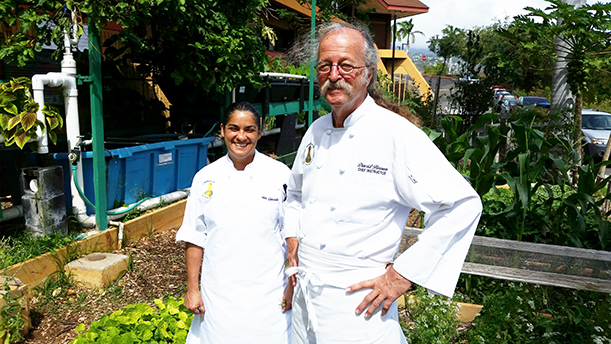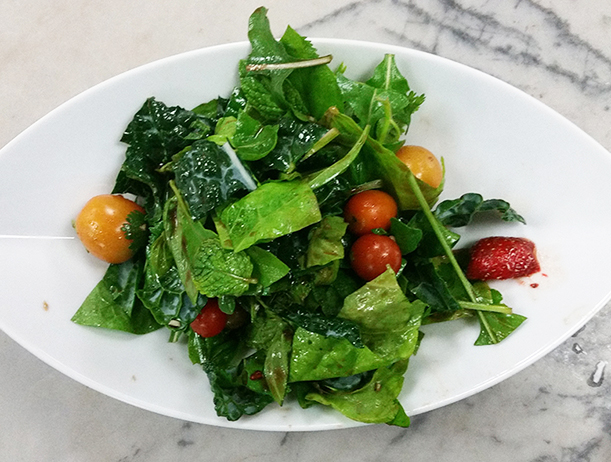By Nathan Kanale Sadowski, Kapi‘o Staff Writer /
KCC culinary student Santos Quesada purposefully wields a sharp, silver pocketknife as she wades into the dense green thicket. She deftly cuts a stem here and branch there until her stiff white apron is filled with rainbow of colors—bright strawberry red contrasted with basil, arugula, monster kale, mint and lettuce green scattered amongst several varieties of red, orange and yellow tomatoes.
“It’s either we use it, or the birds are going to use it, or the rodents are going to use it – and so this garden is open to culinary students and we get to reap the benefits of some really wonderful plants,” Quesada said. “It does not look like this by accident. It’s well maintained. It’s such a clean little garden and it has nothing to do but grow.”
At the end of a long day of classes, work and stress, Quesada retreats to the garden not to do homework, but to find refuge and relief. The sign on the door to the garden below the ‘Ōhelo building reads: “KCC Culinary Arts Edible Garden.”
Retiring after 10 years in the Army and switching her major from business, Quesada is one of many KCC culinary students to regularly visit the garden that is one of many examples of the KCC culinary program’s effort to promote sustainability. The garden uses a closed-loop aquaponics system where there is no need for synthetic fertilizer as the waste from tilapia fish provides nutrients for plants to thrive. Recycled food waste, through worm and compost bins, is also repurposed into a nutrient-rich soil to help plants outside of the aquaponics system grow.
Chef David Brown heads up the KCC culinary initiative responsible for operating the composting bins, vermiculture (worm) bins, aquaponics system fish tanks, plants and soil garden.
“Chef Brown is killing it with this garden,” said student Brian Stone. “He’s probably the best chef in terms of teaching sustainability.”
An exemplary curriculum
Culinary department chair Ron Takahashi began incorporating sustainable practices into the when he initiated recycling food waste several years ago. Since then the program’s sustainable efforts have only progressed.
“When [I started] in the industry, sustainability was not a part of the equation as far as cooking,” said chef Alan Tsuchiyama. “Today, on the other hand, I stress to the students that sustainability is a huge part of cooking.”
Tsuchiyama said that Hawai`i Regional Cuisine has always been forward thinking and successful Hawai’i chefs have supported the idea of “buy local” since the 1980s. Tsuchiyama mentions Alan Wong, Roy Yamaguchi and Ed Kenny among local chefs that institute practices of sustainability and have financially successful restaurants.
“Sustainability in the restaurant business is not a fad,” said Tsuchiyama.
While Brown is responsible for the garden, Tsuchiyama has the responsibility of teaching the intermediate cooking class where students get real-world cooking experience through the 220 Grille, A Sustainable Food Bistro, which is located adjacent to the cafeteria.
“I would say that 80 percent of [the 220 Grille’s] produce is from the islands,” said Tsuchiyama, explaining how the 220 Grille seeks to “buy local,” which supports local farmers and reduces unnecessary transportation costs.
The 220 Grille also features local Shinsato pork, local beef and fish purchased at the O`ahu fish auction.
“So the only protein that we don’t have from Hawaii would be our turkey and the chicken,” he said.
Appetizers and desserts are $3-4, salads are $5-7 and Entrees are $7-8 at the 220 Grille.
Recently, Tsuchiyama instituted a change from disposable to non-disposable plates in the 220 Grille, said Stone.
The culinary program’s sustainable practices were recently recognized by the American Culinary Federation (ACF) in awarding a Seven-Year Exemplary status to the KCC Culinary Program.
“We were an exemplary program because of the sustainability that we have in our program and [because we] actually practice it,” said Tsuchiyama. “Many programs talk about it, but we actually do it. [The ACF accreditors] were ecstatic about it and we were an exemplary program because of that.”
Respecting food and understanding where it comes from
While the program is recognized for multi-faceted effort to be sustainable, Brown insists there is still much progress to make.
“Sustainability is not which garbage bin to put my empty energy drink can in,” said Brown. “That is not sustainability, understand that. It is far more than that. There are massive, massive things that you can do, any individual can do, every single day as long as it involves thinking it through and making the right decision. That decision will basically be personal action greater than separating the wrappers of unsustainable products.”
Tsuchiyama, Brown and Quesada all agreed that an important aspect of culinary sustainability is having “respect” for food.
“It’s about caring for and respecting the food they are working with,” said Tsuchiyama.
Tsuchiyama explained that this respect is demonstrated by a well-known event within the KCC culinary community: the coming of the Shinsato pig. Once every eight-week module, as a part of sustainability week in his intermediate cooking class, Tsuchiyama purchases two whole pigs from Glenn and Amy Shinsato’s pig farm.
“I work closely with Shinsato farms because [Mr. Shinsato] comes over on his own time,” says Tsuchiyama. “He and I help the students and they bring the whole pig down. From there, the students get to see that we use the entire pig in our restaurant so they can actually see how that works versus, ‘oh, I need pork loins, loins,’ we go buy pork loins, or ‘we need shoulder,’ we go buy shoulder.”
Chef Brown noted the significance of having Mr. Shinsato bring in the pig.
“So [Shinato] brings those pigs and he lets students know,” said Brown. “He brings those pigs into life, he takes great care of their health, he takes great care of their death. Those pigs are nourished, slaughtered humanely, dressed….When this guy makes his delivery, it’s like an event at this school. The students talk about it like, ‘Oh my God, you know if you touch that pig it’s gold.’ But, in fact, it is gold.”
Tsuchiyama explains that it’s not just important to use the entire pig, but for the students to actually meet and speak to local farmers.
“It’s about connecting to the farmers and they — really get to know them, almost on a personal basis,” he said. “You want to know what they’re about and what are their difficulties.”
“I didn’t even know I lived down the street from Glenn and Amy at Shinsato farms,” said Quesada. “[T]hey have such a low-key advertisement. I’m not even kidding, it’s like a 4 [inch] by 8 [inch] sign that says ‘Pigs for sale’ tacked on their coconut tree. I used to drive by and say, ‘Man, I bet they couldn’t have good pigs like Shinsato.’ It was Shinsato, little did I know.”
Planting the seeds of sustainability
Brown wears a ponytail and rides a bike to work. He resembles a philosopher and it’s not a surprise when he indicates that he participated in the very first Earth Day, has lived in communes, one lived in a cash-free economy on a Greek island, and spends his free time teaching orphans in Cambodia how to garden.
“The skills that we teach must be relative to some common truth, and ‘business as usual’ is the accepted common truth,” Brown said. “To be an educator and not teach where business as usual is gonna get us is a devastating place, then we fail as educators because business as usual is cataclysmic. It’s cataclysmic.”
Brown emphasized that although students have opportunities within the program to learn about sustainability, there are certain realities that make it difficult for them.
“For those of us who really believe in the importance of sustainability, we never cherry-pick sustainability,” Brown said. “The whole idea of living sustainable is having to do it every time you walk through the world, everything you pick up, how you pick it up. Yeah so it’s a pretty non-stop beat of a drum. This is such a thing that’s contrary to business as usual, at best, it’s the kind of thing that if you can find a student that for one moment see their eyes open up, their ears open, you can actually see the wheel turn, that’s the moment we as educators can put seeds in.”
Brown and Tsuchiyama said that students like Quesada are thinking sustainably.
“[Quesada] was very in tune to what was happening, how could she make a difference as far as the whole community, you know,” said Tsuchiyama. “She’s one of many students that got it and they practice it, so we are in good shape, our future is in good shape with our students.”
Tsuchiyama is optimistic about his students.
“I think our students, a lot of them, actually get it before they get to to class, and we are reinforcing it and we are practicing it,” said Tsuchiyama.
Solving problems, not creating them
As Quesada gathers garden ingredients to cook what she describes as a healthy “family” meal to be shared with culinary colleagues, she explains that she has her own aquaponics system at home. She conscious of small choices that she can make, such as feeding the tilapia in her aquaponics systems with vegetables that she grows rather than unsustainable food pellets. She’s also up to date on current events and trends noting that McDonald’s and other fast food restaurants have been losing money in recent years.
“I’m aware that it doesn’t speak to everybody,” said Quesada. “I get that, you know, but it only takes a couple people to get it, to realize it, to share that, because not everybody knows how to cook, not everybody knows how to fix a car or fly a plane. I’m hoping that is where I can fit in, and pass that info and that gift we have without doing any damage to anyone. Health, environment, security, I want to part of the big picture. I want to be part of the solution. I don’t want to be part of the problem.”
Part of the solution in Quesada’s life was moving her father to live close to her so she could help him battle health conditions. Quesada said her father has lost weight and his health has improved with some of her cooking.
After gathering ingredients, Quesada takes them into the kitchen where she borrows a knife from a colleague as she prepares the salad. As she cuts into the greens and remove the stems from the tomatoes, Quesada exchanges gardening tips with her fellow students.
Quesada has assembled a fresh, healthy salad topped with a light basaltic vinegar-based dressing. The salad is sweet, flavorful and filling.
After finishing the meal, Quesada reflects on how her body feels good and her mind is sharp after eating a healthy salad. “There’s not too many things where you can say, ‘I did good by me and by everyone else,’” she said. “And ‘I didn’t do damage to anybody.’”



